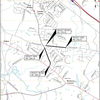Objections raised to abolishing planning board
ALTAMONT — Mayor Kerry Dineen drew the ire of a longtime former colleague over her handling of a proposal to abolish the village’s planning board.
Last month, the mayor presented a local law that would do away with Altamont’s planning and zoning boards and replace them with a single zoning board of appeals whose “powers and duties” would comprise both bodies.
During a Tuesday public hearing on the proposal, Dean Whalen, who’d been a trustee for 16 years before declining to run for a fifth four-year term last year, took issue with what could be considered a rather large change to the proposed law.
As presented to the public for the past month, the law would do away with both boards and in their place create a seven-member voting body with one alternate.
However, the mayor’s intention was actually to have the new zoning board made up of five voting members and two alternates.
What appeared to upset Whalen was how the bill continued to be portrayed in its incorrect iteration for the near-entirety of Tuesday’s public hearing.
As public comment had ended, Dineen asked her fellow board members to keep open the hearing for another month because the law as written included a “miscommunication,” where “the wrong piece got crossed off.”
Whalen asked if the new board would indeed be five regular members and two alternates, which Dineen said was correct. “Well, that’s not what’s been stated so far,” Whalen said.
Village attorney Allyson Phillips jumped in to say she had incorrectly numbered the members of the new zoning board. “The discussion was about increasing that to seven, but the intent was a five-member board with two alternates,” Phillips said. She said she had “changed the voting membership from five to seven.”
Dineen said the five-member zoning board with two alternates is what was discussed at January’s meeting, but she had missed where the bill said that the new board would be made up of seven voting members and one alternate.
Dineen, on Jan. 4, never mentioned how many members the new board would have; the only arithmetical reference was an observation that “filling 12 slots,” the number of total planning and zoning members when the boards are fully appointed, which are “constantly rotating, is tricky.”
Whalen got up again to address the issue.
“What’s been represented in the document posting for the public hearing may have been an error,” he said. “But we started the conversation tonight, you talked about a seven-member board and your intent was to have more people sitting on that board — voting. That’s not what you’re now talking about.”
Dineen said she hadn’t realized her “phrasing was off,” and what she said earlier in the meeting wasn’t intentional. Whalen spoke over the mayor to tell her, “You did,” which Dineen acknowledged she did.
“It’s a totally different thing,” Whalen said.
Dineen asked her fellow trustees if they would be OK with moving forward with the five-member board and, after only Trustee Nicholas Fahrenkopf was willing to entertain the idea, the other present trustees, Michelle Ganance and John Scally (Tresa Matulewicz wasn’t at Tuesday’s meeting), had little to add.
The board then decided to keep the public hearing open and draft a new law that clarified the makeup of the new zoning board.
The hearing
“This was an idea that came up a little while ago, you know, looking at some of the applications we’ve had over the years, and how they’ve gone back and forth” between the planning and zoning boards, Dineen offered by way of explanation for merging the two boards. “We’re looking at ways to streamline the process.”
The mayor said the move would also save the village money.
She said Altamont spends money to train board members. And some are able to apply what they’ve learned because their board meets often enough to use and retain the training, while “some boards don’t do that,” Dineen said, referring to the zoning board’s sparse meeting schedule as of late.
Dineen said her proposal “abolishes both boards, true,” but she added that any of the current planning or zoning board members who wanted a seat on the new board would have one, “unless somebody decided they didn’t want” to serve.
She also said both current board chairs have signed off on the proposed restructuring.
Harvey Vlahos, a former village trustee, said he thought both boards should be kept because “they have complementary functions,” but also offer “two different perspectives on what their jobs are.” Vlahos questioned the need for streamlining the review process in part because so few projects are proposed in the village.
“That’s for the applicants,” Dineen said, in reference to streamlining, “not for us.”
Vlahos made the point that when Maurice McCormick wasn’t reappointed to the zoning board, it was under the guise that “there a lot of people that want to serve,” but now trustees are contemplating reducing the number of seats available from 10 to seven — which is what the public in attendance thought was the case at that point in the meeting.
“So it doesn’t seem like it reconciles,” Vlahos said, while making a plea for transparency in the same breath. If there’s to be an appointment to a board, regardless of which, Vlahos said, “it’s something that would materially impact the village,” so there should be some kind of public announcement of the vacancy “so that people can apply for these positions.”
Vlahos had clearly thought a lot about appointments because he came armed to the Feb. 1 meeting with his own language to amend the village code so that, “When a vacancy occurs in any board position, village board, zoning board of appeals or any other board, permanent or temporary whose actions will materially affect the village such as the Referral Committee, all such positions shall be subject to public notice in all locally available media, including but not limited to The Enterprise, the village bulletin board on Main St, the village web site and Nixle. Candidates may express their interest and submit résumés if so desired and the mayor and trustees will review and appoint a candidate(s) subject to a village board vote.”
McCormick, who’d been on the zoning board for two decades and its chairman for 15 years, offered his first comment wrapped in a question: “One of the reasons” for abolishing the planning board is that “you’re not able to get people, I guess, you’ve got a lack of volunteers.”
Dineen quickly interjected and shot down McCormick’s line of thinking, and said “No; no, we’re looking at the function of the boards. Actually, that was the main thing, the function of it.” She also said the move would create a more “streamlined [process] for applicants, [and] financial savings for the village.”
Dineen continued, “All those are the three main reasons that we’ve been talking about,” adding other municipalities larger than Altamont have done away with having two land-use boards, which “seems to [have] work[ed] very well for them.”
McCormick next took issue with Dineen’s earlier comment about applicants having to trudge back and forth between the two boards. In his 20 years on the zoning board, save for Stewart’s half-decade attempt to get a new Altamont store built, “everything seemed to get done at one time.”
McCormick then built on the transparency plea from Vlahos by asking what Dineen’s procedure was for appointing residents to village boards. She responded the procedure had remained largely unchanged since Vlahos’s time, some 13 years ago: “Basically, if there’s a spot, I reach out to the trustees, and I ask them if they would like to spread the word, and do they know anybody that would be interested in doing this?”
McCormick said he’d been approached in the past by residents asking about serving on a board, and he was able to tell them where they should go, but “there’s a lot of people in the village that just aren’t connected with maybe some of the board members.” He then echoed Vlahos’s point about appointment transparency, and asked if “the village ever considered putting” out some kind advertisement about the vacancy.
Dineen responded, “I think that’s something we could look at in the future,” but added the village hadn’t had much trouble filling board seats with residents who were asked to serve by either a trustee or the mayor herself.
Comprehensive plan
The adoption of the village comprehensive plan flipped the power between the two boards.
Whalen said that, at the time the comprehensive plan was being drafted, prior to its December 2006 adoption, the planning board was in the situation the zoning board currently finds itself in: It rarely met.
Between 2011 and 2022, including this month’s scheduled meeting set for Feb. 22, the zoning board has met approximately 38 times, according to an Enterprise tally of meeting minutes from those years. The planning board over the same period met about 63 times.
Whalen said the comprehensive plan was meant to serve as a guide for the planning board, because it was getting ready to become “the lead agency in matters once covered by the zoning board of appeals,” The Enterprise reported in 2007.
With the 2008 adoption of the zoning based on the comprehensive plan, the new code stated the planning board is to “ have all of the powers” related to site-plan and subdivision review, as ascribed in the state’s Village Law.
“Contrary to some municipalities,” Whalen said on Tuesday, “there was a bit of a flip to where the planning board took on special-use permits.”
The intent of the change was to keep the planning board informed about changes that were happening in the village, Whalen said, “so when there was a planning issue — that was intent — when there was a planning issue, [the planning board] would already be aware of some of the changes the [zoning board] had made — maybe not being aware of that the ZBA had made those changes,” Whalen said.
Saving a buck
Dineen stated more than once on Tuesday that abolishing the planning board, “fiscally, it does help us,” but when asked by McCormick if she had a number she could offer the public, she responded, “Not a concrete [number], no.”
Vlahos got back up after McCormick spoke and asked again about what kind of savings the village could see, to which Dineen quickly interjected, “I don’t have a number for you right now.” Vlahos then asked, “Why base a decision on something you don’t have the money on.”
The total line item associated with the planning board in Altamont’s 2021-22 budget is about $4,400.


